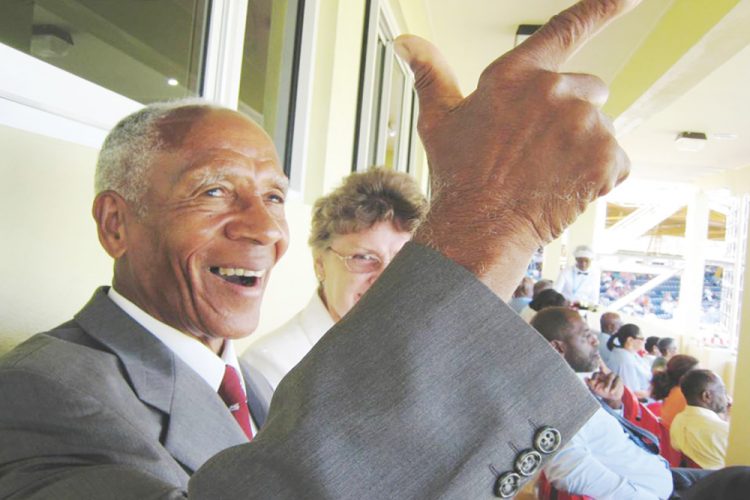A non-literary review of Dr. Cyrus’s ‘A Hotchpotch, a Literary Amalgam: The final Swan Song of a Caribbean surgeon’

by Ambassador Andrea Bowman
Within thirty-two (32) conversationally written pages, Dr. Sir. A.C.Cyrus captures what has been labelled his ‘final swan song’.
This booklet, coming after A POTPOURRI:THE SWAN SONG OF A CARIBBEAN SURGEON (2020), is entitled A HOTCHPOTCH,A LITERARY AMALGAM: THE FINAL SWAN SONG OF A CARIBBEAN SURGEON. It was published on 24th November, 2021 and comprises two chapters. These chapters are respectively titled ‘RACIAL PREJUDICE’ and ‘FUNCTIONAL HYPOGLYCAEMIA (LOW BLOOD SUGAR)’. The booklet’s DEDICATION serves as a FOREWORD where Dr. Cyrus explains the two considerations which ‘forced’ him to write again after he had decided to stop. He writes, “…after the recent 2021 European Championships in which Italy beat England because a Negro player kicked a penalty shot straight at the Italian goal-keeper who saved it…racial prejudice raised its ugly venomous head.” His other consideration was the dangerously high incidence of undiagnosed functional hypoglycaemia or low blood sugar in our societies.
We are very grateful that our iconic and internationally acclaimed Vincentian surgeon remains pertinently, socially and responsibly engaged such that he dedicated his energy to this work. His use of the term ‘Negro’ dates him, but he argues passionately for the dignity of this term as opposed to other racial references. In the booklet’s first chapter he writes, “…the word coloured, favoured by some of us, instead of Negro,was a not-too-subtle compromise, a cover-up for our disgusting shame at being Negroes”(pgs.20-21). This chapter also chronicles the racial prejudice meted out to him in the 1950s and 60s at Queen’s University in Belfast, from Irish women in particular as well as from fellow West Indians of another race who were not ‘white’. His frank reflections refer to these “misguided fools in the world” as “miscreants who thought that their lack of adaptive, protective pigmentation automatically made them my superiors”(pg.12). Indeed, Dr. Cyrus’s intellectual property was also subjected to racism in the 1990s when a librarian at the Welcome Trust in London suggested that “[his] book would be of interest to Negroes only…he said, “try America:there are thirty million Blacks [there]”(pg.19).
In the fraught realities of the first quarter of our 21st century,where racism is blatantly, politically and socially weaponized, our good doctor’s conclusion that “racial prejudice is one of the greatest malignancies of human conduct”(pg.24), resonates with a painful anger. This anger is sometimes regarded as a base emotion which is not intellectually appropriate. Yet, the authentic legitimacy of enduring anger towards racial prejudice should not be cowed by the niceties of intellectualism.
The booklet’s second chapter is equally passionate and frank in its crusade for the recognition and acceptance of the diagnosis of functional hypoglycaemia to be regarded as a clinical diagnosis. He states, “because I myself have been a victim for the greater part of my life, as time passed, it became increasingly easy to recognize this condition”(pg.27). After thirty-eight (38) years of practice he records a plethora of cases in this chapter, some from his own family, which support his diagnosis and his quest. He states:
Functional hypoglycaemia is not merely of nuisance value. The ravages of an overdose of insulin to a diabetic patient are among the most urgent of emergencies.
If the low blood sugar is not corrected by the prompt administration of sugar in whatever form or by whatever route, the person may die or, if he survives, he may be crippled mentally and become a vegetable (pg.37).
He explores the probability of a hereditary component to this disease and he wonders aloud if some unexplained deaths,”including those during the administration of a general anaesthetic, could be due to the effects of low blood sugar on the brain because of failure to prevent this…moreover, an intravenous infusion of glucose might eliminate or confirm its diagnosis in the unconscious patient”(pg.36). The final sentence of this chapter and this booklet underscores the urgency of his plea. He writes,”I have deliberately placed this chapter at the end of this book so as to ensure that it will have a better chance of being read and assessed as of great importance”(pg.41). Thank You Dr. Sir. A.C.Cyrus!









